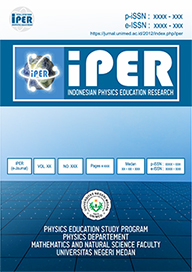QUALIFICATION OF PHYSICS TEST INSTRUMENTS LIKE-PISA
Abstract
Keywords
Full Text:
PDFReferences
Arifin, Z. (2015). Evaluasi Pembelajaran. Bandung: pt. Remaia Rosdaka.
Arikunto, S. (2012). Evaluasi Program Pendidikan. Jakarta: Bumi Aksara.
Basuki. (2014). Asesmen Pembelajaran. Bandung: PT. Remaja Rosdakarya Offset.
Dewi, A. M., & Haryani, S. (2022). Development of a Three-Tier Test Instrument Based on Scientific Literacy in Electrolyte and Non-Electrolyte Solution Topics. 5(1), 1–16.
Erniwati, E., Istijarah, I., Tahang, L., Hunaidah, H., Mongkito, V. H. R., & Fayanto, S. (2020). Kemampuan Literasi Sains Siswa Sma Di Kota Kendari: Deskripsi & Analysis. Jurnal Kumparan Fisika, 3(2), 99–108. https://doi.org/10.33369/jkf.3.2.99-108
Kemendikbud, B. (2019). Pendidikan di Indonesia belajar dari hasil PISA 2018. Pusat Penilaian Pendidikan Balitbang KEMENDIKBUD.
Lawshe, C. H. (1975). A Quantitative Approach To Content Validity. Personnel Psychology. https://doi.org/10.1111/j.1744-6570.1975.tb01393.x
OECD. (2019). Programme for international student assessment (PISA) results from PISA 2018. Oecd.
Permatasari, P., & Fitriza, Z. (2019). Analisis Literasi Sains Siswa Madrasah Aliyah pada Aspek Konten, Konteks, dan Kompetensi Materi Larutan Penyangga. EduKimia. https://doi.org/10.24036/ekj.v1i1.104087
Rizkita, L., Suwono, H., & Susilo, H. (2016). Analisis Kemampuan Awal Literasi Sains Siswa Sma Kota Malang The Analysis Of Initial Ability Of Student’s Scientific Literacy In High School In Malang. Prosiding Seminar Nasional II.
Sutrisna, N. (2021). Analisis Kemampuan Literasi Sains Peserta Didik SMA di Kota Sungai Penuh. Jurnal Inovasi Penelitianitian.
Thiagarajan. (1974). Thiagarajan, Sivasailam; And Others Instructional Development for Training Teachers of Exceptional Children: A Sourcebook. Indiana Univ., Bloomington. Center for Innovation. Research and Development.
DOI: https://doi.org/10.24114/iper.v3i1.63106
Article Metrics
Abstract view : 35 timesPDF - 14 times
Refbacks
- There are currently no refbacks.

Ciptaan disebarluaskan di bawah Lisensi Creative Commons Atribusi 4.0 Internasional.




